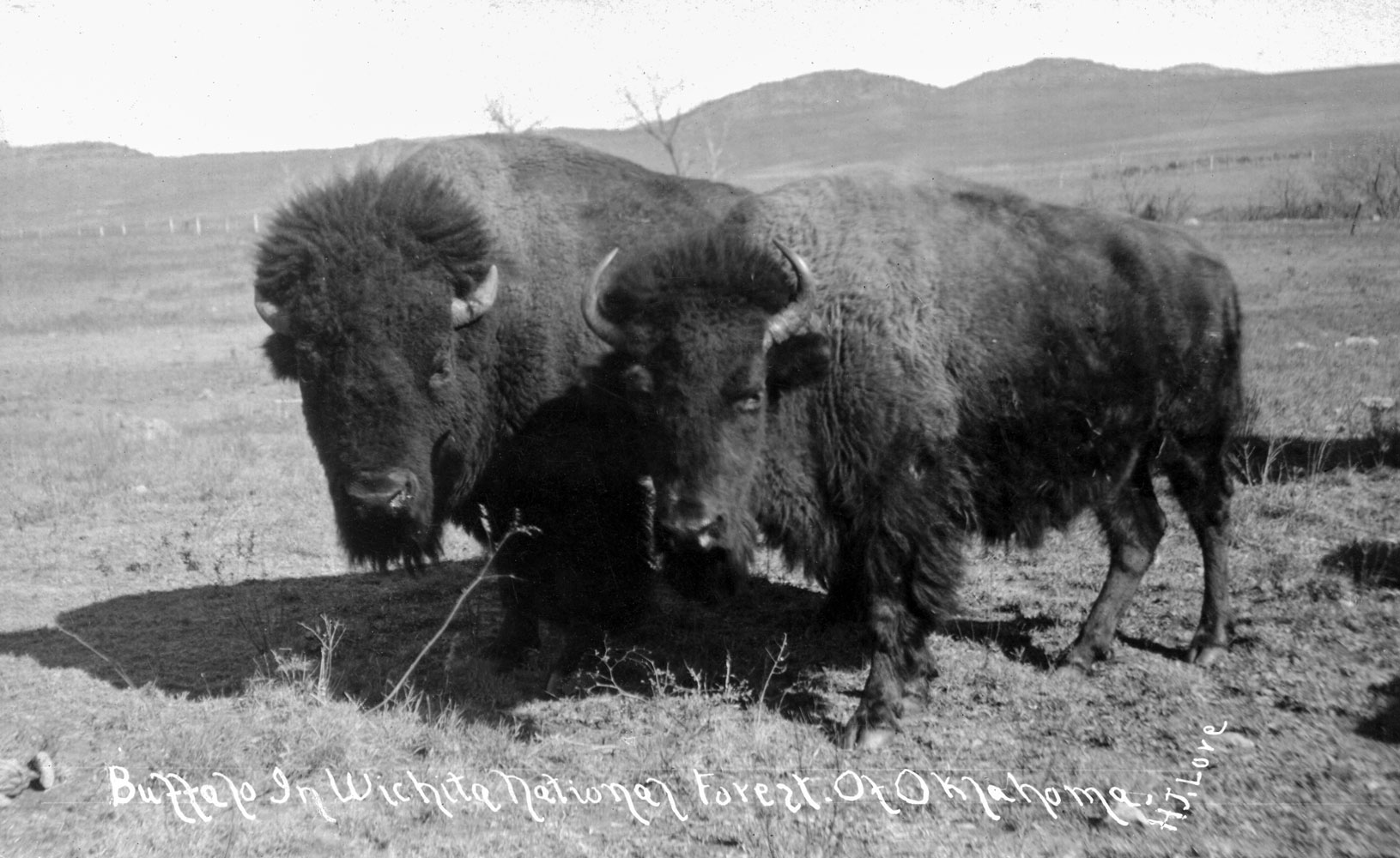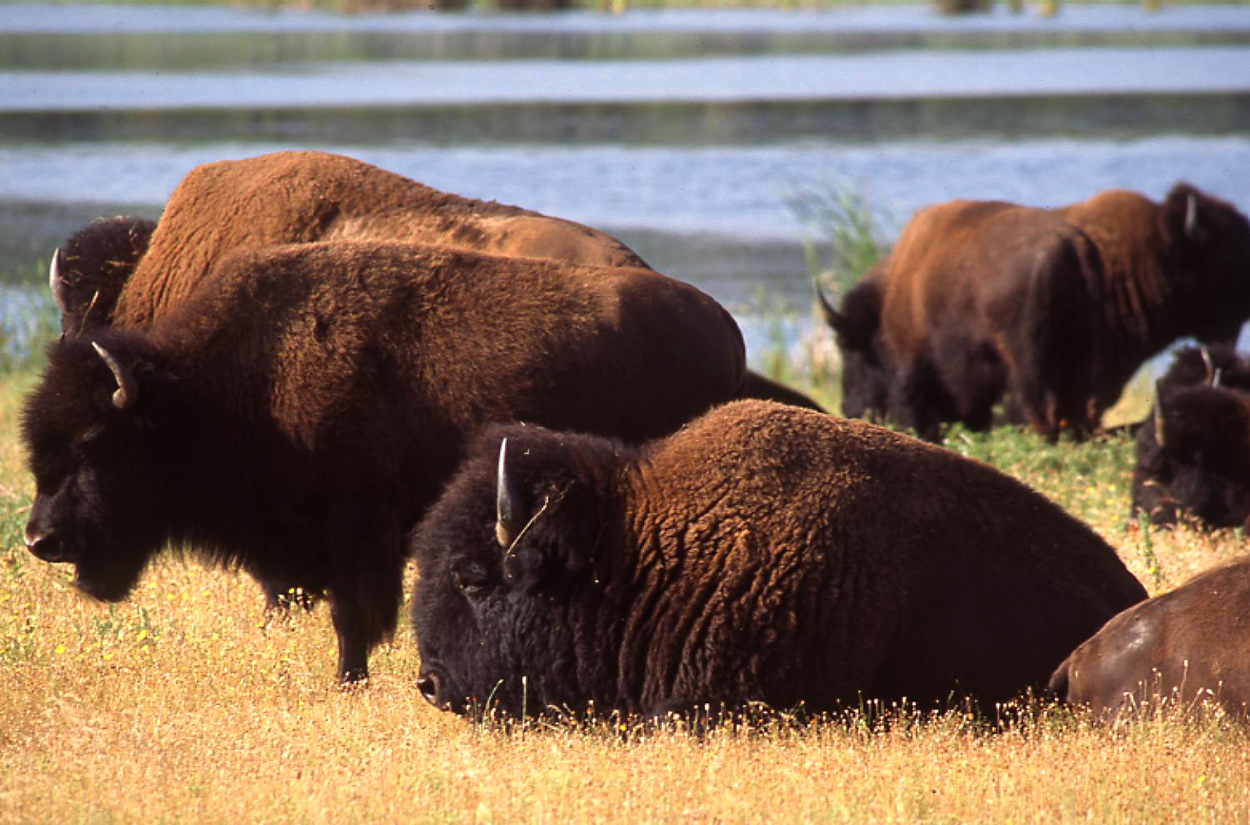BISON (Buffalo).
The largest extant North American land mammal, American bison (Bison bison) are members of the mammalian order Artiodactyla, family Bovidae. Males may reach weights of over 1,984 pounds (900 kilograms). Females are considerably smaller, reaching maximum weights of 1,201 pounds (545 kilograms). Both sexes possess true horns; male horns are larger and are not shed. Bison are gregarious grazers, selectively foraging on a number of different grass and herb species. Male "rut" and mating occurs in July and August, with females giving birth to a single calf after a nine-and-one-half month gestation period. Bison once numbered in the tens of millions but were brought to the brink of extinction in the late nineteenth century primarily due to the efforts of commercial hide hunters. "Buffalo," as they are often incorrectly called (true buffalo are Old World species), were so numerous that the term "buffalo" or "bison" has been incorporated into many Oklahoma place-names, including Buffalo Creek, Buffalo Springs, and the small town of Bison in Garfield County.
Bison were keystone species of the Great Plains. Their grazing and trampling habits have had a significant impact on grassland plant species and plant communities. Coupled with fire, these activities helped establish the distribution of grasslands within the Great Plains. Buffalo wallows, shallow depressions in the ground created by bison taking dust baths, also provide resources for a number of animal species in the form of ephemeral sources of surface water. Perhaps no other animal is more associated with American Indian people than the bison. Tribes such as the Cheyenne, Lakota, Crow, Pawnee, Arapaho, Assiniboine, Kiowa, Plains Cree, Omaha, Comanche, Kansa, and Shoshone had cultures interwoven with the mammal.
At the end of the twentieth century about three hundred thousand bison roamed North America. A mere shadow of the once immense herds that thundered across the prairie, they are mostly confined to parks, preserves, and other public lands, as well as some private ranches. Several large, free-roaming herds occur in Canada as well as the in United States, such as in Yellowstone National Park. In Oklahoma large herds are maintained at the Wichita Mountains Wildlife Refuge in Comanche County and the Tallgrass Prairie Preserve in Osage County. The Oklahoma Historical Society's Pawnee Bill Ranch, near Pawnee, also manages a herd. Interestingly, Spanish explorer Francisco Vásquez de Coronado may have been the first white man to observe and describe bison in what is now Oklahoma as he traveled eastward from New Mexico in 1542.
See Also
Learn More
William J. Caire, Jack D. Tyler, Bryan P. Glass, and Michael A. Mares, The Mammals of Oklahoma (Norman: University of Oklahoma Press, 1989).
A. K. Knapp et al., "The Keystone Role of Bison in North American Tallgrass Prairie," BioScience 49 (1999).
Dennis L. Olson, Shared Spirits: Wildlife and Native Americans (Minocqua, Wisc.: NorthWord Press, Inc., 1995).
J. H. Shaw, "American Bison (Bison bison)," in The Smithsonian Book of North American Mammals, ed. Don E. Wilson and Sue Ruff (Washington, D.C.: Smithsonian Institution Press, 1999).
Citation
The following (as per The Chicago Manual of Style, 17th edition) is the preferred citation for articles:
Gregory A. Smith, “Bison,” The Encyclopedia of Oklahoma History and Culture, https://www.okhistory.org/publications/enc/entry?entry=BI013.
Published January 15, 2010
© Oklahoma Historical Society




